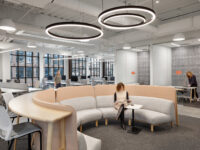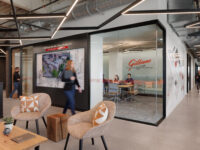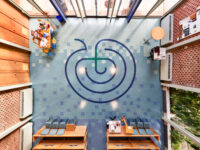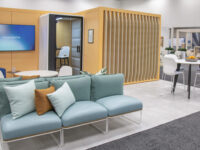Deliberate inclusive design benefits employers and employees alike. Diversity has become a central topic in hiring conversations, with 76% of workers reporting that they consider diversity when seeking employment. Moreover, it boosts employee satisfaction by 50%. Diverse teams offer employers numerous advantages, including the introduction of new experiences and perspectives. For instance, Interaction UK reported diverse teams are 70% more likely to capture new markets and 120% more likely to hit financial targets.
More diverse workforces require environments designed to accommodate diverse needs. This guide outlines how to create a sensory-friendly office, including the common problems that go unnoticed in design and actionable strategies to create a more inclusive, accommodating space in the workplace.
How to Support Neurodivergent Employees in the Workplace?
There are many dimensions of diversity, ranging from age, education, occupation, and leadership style. Neurodiversity, a word coined in 1198, recognizes that each brain develops uniquely. The Harvard Business Review found neurodiverse teams boost productivity by over 30%, further reinforcing neurodiverse teams as critical assets to a diverse workforce.
Neurodivergence encompasses applied, clinical, and acquired conditions. Many neurodivergent conditions can co-exist with sensory sensitivities, making interaction with the environment challenging. In fact, approximately 30% of the total population is thought to have sensory processing sensitivity (SPS).
Hypersensitive vs Hyposensative
One important distinction to remember is someone can be hypersensitive–a heightened awareness or overreaction– to one form of external stimuli while being hyposensitive–an underreaction or decreased awareness–to another. Someone who is hyposensitive may require more intense exposure to a stimulus, while someone who is hypersensitive might need a reduced level.
Inclusive Design for the 8 Senses
Inclusive design places people at the heart of the design process. Acknowledging the diversity in our workforce paves the way for an intuitive understanding that our work environment should offer flexibility and autonomy to allow each diverse individual to find a way to work that suits them best.
Inclusive design requires a consideration for each of one’s individual senses. It’s widely known there are 5 primary senses, but did you know there are actually 8 sensory senses? Read on for what each sense entails and the primary struggles these senses play in workplace design.
Visual
Visual stimuli include light, colors, and patterns. Visual sensitivities may affect how individuals perceive these elements. For example, a flickering light that is imperceptible to most may overwhelm those with visual sensitivities.
Auditory
One’s auditory sense is based on sound. The auditory system responds faster and distractions can quickly detail people when doing focus work. Sensitivities are triggered by these environmental situations:
- Too Loud
- Too Quiet
- Pitches & Tones
- Specific Sounds
- Repetitive Sounds
Tactile
Tactile, or “touch” refers to your ability to feel soft and hard touches, as well as different textures. Those who have tactile sensitivities may be unable to differentiate between soft touch and hard touch. For instance, a hypersensitive person might overreact to a light tap, while a hyposensitive person might not register it at all.
Olfactory
The Olfactory sense refers to scents. Hypersensitive individuals may smell things others can’t, including offputting and unpleasant smells. Conversely, some may prefer stronger scents if they have a hyposensitive olfactory sense.
Gustatory
Your gustatory sense involves one’s nourishment. This includes the textures and taste of foods and beverages we consume. An example of this involves workplaces with an on-site cafeteria. If the available foods lack variety and are only served with the same textures (ie. all crunchy, all soft), this can negatively affect employees.
Vestibular
The vestibular sense governs balance. In a work setting, consider how navigating through the office safely could feel if balance is of concern. Elements of a workplace that can cause strife include:
- A Disorganized Space
- Narrow Walkways
- Sharp Corners
- Confusing Patters
Proprioception
Proprioception is the awareness of what the body is doing, even if one’s eyes are closed. When people have proprioceptive challenges, the brain is struggling to interpret and give meaning to sensory input. In the workplace, a hyposensitive reaction could cause challenges because it can result in the inability to sit still and the desire to seek out movements like jumping, swinging, and running.
Factors that negatively affect proprioception include:
- Lack of Movement
- Poor Ergonomic Support
- Narrow Walkways
- Sharp Corners
Interoception
Interoception, referring to interpretation, affects self-awareness, problem-solving, social understanding, and flexible thinking. Individuals with interoceptive challenges may struggle with attention and experience heightened anxiety over minor issues.
How to Make an Office More Sensory-Friendly?
These eight senses can stand alone, however, they often link together and play an exponentially more crucial component in workplace design and the sensory experience of the team.
The Broader Environment
For vestibular, proprioceptive, and interoceptive needs, consider these strategies:
- Ensure walkways are wide and free of sharp corners.
- Incorporate navigational cues, such as signage and landmarks.
- Provide spaces that support movement, such as areas for rocking or stretching.
Customization
For the remaining senses, flexibility is key. Allow employees to adjust temperature, lighting, and noise levels to create a workspace tailored to their needs.
Dedicated Spaces
When customization isn’t feasible, offer dedicated zones tailored to either hypersensitive or hyposensitive individuals. This allows individuals to identify the environment that suits them best, even when there are no real-time customization options.
Office Design for Sensory Sensitivities
Let our experts at King Business Interiors help in creating flexible workspaces for sensory needs with our space planning services. We can help identify unique solutions for your office to feature adaptable, sensory-friendly zones with simple modifications to better accommodate neurodivergent employees and foster a more comfortable and supportive work environment for everyone. Contact us today to get started.



